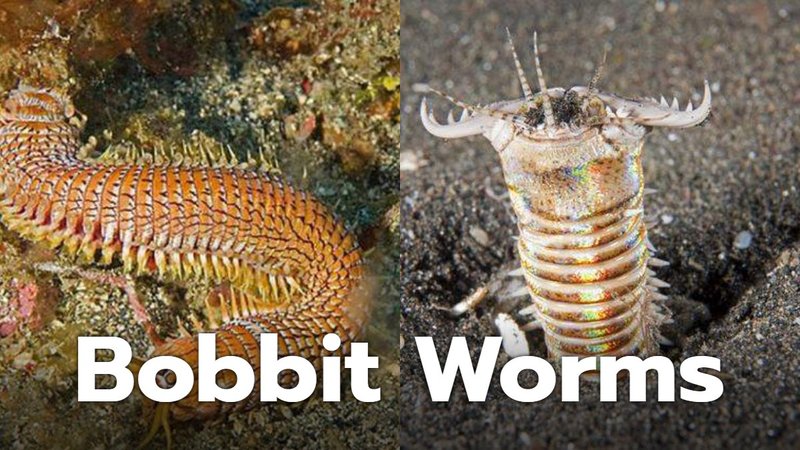
In this article, we’ll dive into the fascinating world of the Bobbit worm, comparing its attack speed to that of other types of worms. By the end, you’ll not only know why the Bobbit worm is noteworthy, but you’ll also understand how it stacks up against other species in the wild. So grab your favorite drink, and let’s get started!
What is a Bobbit Worm?
The Bobbit worm, scientifically known as *Eunice aphroditois*, is a marine creature that can grow up to 10 feet long. Its long, segmented body is often camouflaged among rocks or sand, making it an expert ambush predator. When you think of a worm, you likely imagine something soft and squishy, but the Bobbit worm has powerful jaws that can snap shut with startling speed.
You might be wondering what makes them so effective as predators. Bobbit worms are known for their incredible patience. They lie hidden in their burrows for hours, waiting for fish or crustaceans to swim by. And once they detect movement, they strike with **incredible speed**, grabbing their prey before it even knows what hit it. It’s like waiting for the perfect moment to catch a fly with a chopstick—quick and precise!
Comparison of Attack Speed
Now, let’s talk about speed. The Bobbit worm has been recorded to strike in as little as **0.5 seconds**—that’s fast! To put this into perspective, let’s compare this to other common worms.
1. **Earthworms**: Generally, earthworms move slowly. They can wiggle through the ground at about **2-3 inches per minute**. They’re built for burrowing, not for striking.
2. **Flatworms**: With a bit more agility than earthworms, some flatworms can move at about **0.15 inches per second**. They have a simple movement mechanism that relies on their cilia, making them relatively slow, especially compared to the Bobbit.
3. **Nematodes**: These tiny roundworms can swim and wriggle quite fast for their size, but still don’t come close to the Bobbit worm’s speed. Their maximum speed is around **1 inch per minute**.
So, when it comes to speed, the Bobbit worm clearly wins. It’s like comparing a cheetah to a tortoise—one is built for speed, while the other is more about taking it slow and steady.
How Does the Bobbit Worm Strike?
It’s essential to understand the mechanics behind the Bobbit worm’s incredible speed. The strike is a combination of muscle contraction and reflexes. When the worm senses vibrations or movement in the water, it initiates a rapid, powerful contraction of its muscles. This allows it to lunge forward astonishingly fast.
Here’s the thing: the Bobbit worm doesn’t just rely on brute strength. Its **jaws** can snap shut with a force that’s surprising for its size. Think of it like a scene from a movie where the hero swiftly draws a sword and strikes before the enemy knows what’s happening—only, in this case, the enemy is a curious fish!
An additional factor in its speed is its efficient body structure. A streamlined body helps it make swift movements, allowing the worm to not just catch prey but also evade predators. It’s a skillful dance of survival in the underwater world.
Why Speed Matters in the Wild
You might wonder, why does speed matter so much for a creature like the Bobbit worm? Well, in the wild, the competition is fierce. Speed can mean the difference between a meal and just being another creature that goes hungry.
Faster predators can catch food more effectively, ensuring they get enough nutrients to survive. For the Bobbit worm, its **quick strike** allows it to take advantage of unsuspecting fish that swim too close to its hiding spot. This predator-prey dynamic is essential in keeping the ecosystem in balance.
Plus, by moving quickly, the Bobbit worm can dodge threats. While it relies on camouflage to avoid being spotted, a fast reaction time is invaluable if a larger predator comes snooping around.
Comparing Hunting Techniques
The Bobbit worm’s hunting style is different from that of other worms. Some worms rely on *filter feeding* or *scavenging*, which means they aren’t actively hunting for food like our friend the Bobbit.
1. **Filter Feeders**: For example, some marine worms filter plankton and organic materials from the water. They have a much slower-paced lifestyle, lying in one spot and sifting through water currents.
2. **Scavengers**: Other worms might scavenge for decaying materials rather than actively prey on others. This means they don’t need the same speed or striking ability as the Bobbit worm.
The difference here isn’t just about speed; it’s about strategy. Bobbit worms are **active hunters**, making them unique among their relatives. Their need for quick strikes sets them apart in the animal kingdom.
In the grand scheme of underwater creatures, the Bobbit worm stands out not only for its striking speed but also for its predatory tactics. While other worms take the slow and steady route, the Bobbit worm is the quick draw of the ocean floor, capable of capturing prey with a speed that leaves others in the dust.
So, next time you think about worms, remember this fascinating creature and its quick strike. The Bobbit worm is more than just a long, colorful worm; it’s a master of the ambush, showcasing the beauty of evolution in action. Whether it’s speed, strategy, or sheer survival, the Bobbit worm has carved out a unique niche that keeps it thriving in its marine habitat.

